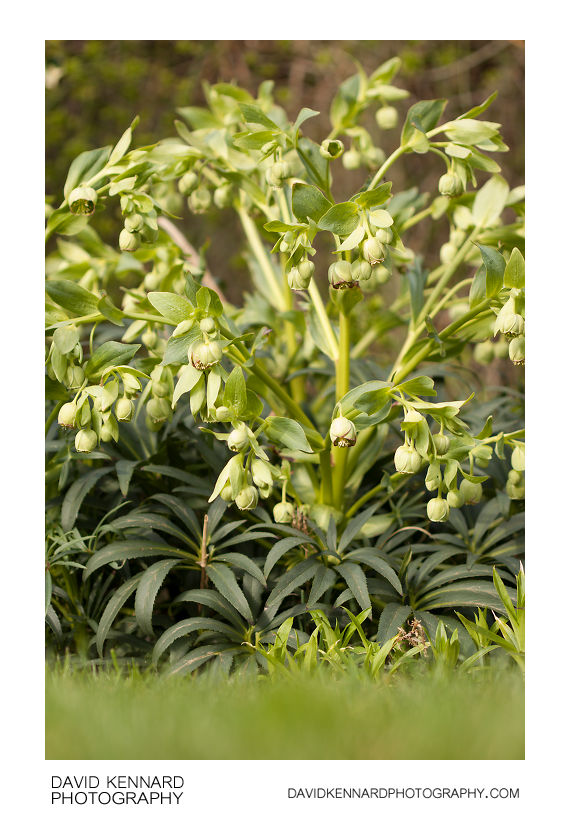Helleborus foetidus in flower

Description
- Title:
- Helleborus foetidus in flower
- Caption / Description:
-
Helleborus foetidus, known variously as stinking hellebore, dungwort, and bear's foot, is a member of the buttercup family Ranunculaceae, native of the mountainous regions of Central and Southern Europe, Greece and Asia Minor. Found wild in many parts of England, especially on a limestone soil.
It is a herbaceous perennial plant growing to 80 cm tall and 100 cm across, with a thick succulent stem and evergreen glossy leaves. Flowering is in spring, usually on lime-rich soils. The drooping cup-shaped flowers are yellowish-green, often with a purple edge to the five petal-like sepals on strongly upright stems.
The flowers, typically for the family, contain numerous stamens as well as up to ten nectaries which make them attractive to bees and other insects. Each flower produces up to five (usually three) wrinkled follicles. Despite its common name, it is not noticeably malodorous, although the foliage is pungent when crushed.
It is grown in gardens for its handsome evergreen foliage and large numbers of green, bell-shaped flowers borne in late winter.
Description from Wikipedia: http://en.wikipedia.org/wiki/Helleborus_foetidus
- Tags / Keywords:
-
- Biota
- Life
- Vitae
- Eukaryota
- Green
- Plantae
- Plants
- Magnoliophyta
- Flowering Plants
- Angiosperms
- Magnoliopsida
- Dicotyledons
- Buttercups
- Ranunculales
- Ranunculaceae
- Helleborus
- Helleborus foetidus
- Stinking Hellebore
- Dungwort
- Bear's foot
Admin
- Date Original Photo Taken:
- Original File Name:
- _MG_5968.CR2
- Event:
- Rating:
- ☆
- Date this image added/last updated on website:
- Original File Dimensions:
- 2723px x 4085px
- File Type:
- JPEG
- Color Mode:
- RGB
- Original Image Color Profile:
- Adobe RGB (1998)
Location
- Location Created:
-
- Sublocation:
- City:
- Market Harborough
- Province/State:
- Leicestershire
- Country:
- United Kingdom
- World Region:
- Europe
- Geo-location:
Rights
- Copyright Status:
- Copyrighted
- Licensing Status:
- Rights Managed
- Available for Editorial Use:
- Yes
- Available for Commercial Use:
- Yes
- Copyright Notice:
- © 2011 Dave Kennard
Camera Data
- Date Digital Resource was created:
- Shutter speed:
- 1⁄250 s
- Aperture:
- f/2.8
- Camera Model:
- Canon EOS 450D
- ISO:
- 100
- Exposure Compensation:
- 0
- Focal Length:
- 100mm
- Focal Length (35mm equiv.):
- Metering Mode:
- Center-weighted average
- Flash:
- Off, Did not fire
- Exposure Mode:
- Manual
- White Balance:
- Manual
- Light Source:
- Exposure Program:
- Manual
Additional shooting metadata
- Lens:
- Canon EF 100mm F2.8 Macro USM
- Filters used:
- Additional Optics used:
- Setup:
- Handheld
Post Processing
- Image Modified:
- Software used:
-
- Adobe Camera RAW
- Post Processing:
-0.75 exposure compensation in ACR
Straightened in ACR
